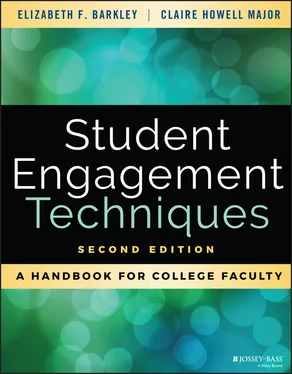Elizabeth F. Barkley - Student Engagement Techniques
Здесь есть возможность читать онлайн «Elizabeth F. Barkley - Student Engagement Techniques» — ознакомительный отрывок электронной книги совершенно бесплатно, а после прочтения отрывка купить полную версию. В некоторых случаях можно слушать аудио, скачать через торрент в формате fb2 и присутствует краткое содержание. Жанр: unrecognised, на английском языке. Описание произведения, (предисловие) а так же отзывы посетителей доступны на портале библиотеки ЛибКат.
- Название:Student Engagement Techniques
- Автор:
- Жанр:
- Год:неизвестен
- ISBN:нет данных
- Рейтинг книги:3 / 5. Голосов: 1
-
Избранное:Добавить в избранное
- Отзывы:
-
Ваша оценка:
- 60
- 1
- 2
- 3
- 4
- 5
Student Engagement Techniques: краткое содержание, описание и аннотация
Предлагаем к чтению аннотацию, описание, краткое содержание или предисловие (зависит от того, что написал сам автор книги «Student Engagement Techniques»). Если вы не нашли необходимую информацию о книге — напишите в комментариях, мы постараемся отыскать её.
— — — —
Student Engagement Techniques
"Student Engagement Techniques
"Student Engagement Techniques
"This book is an essential resource for faculty seeking to better engage with their students. Anyone seeking a clear, research-based, and actionable guide needs a copy of Student Engagement Techniques on their shelf!"
Student Engagement Techniques — читать онлайн ознакомительный отрывок
Ниже представлен текст книги, разбитый по страницам. Система сохранения места последней прочитанной страницы, позволяет с удобством читать онлайн бесплатно книгу «Student Engagement Techniques», без необходимости каждый раз заново искать на чём Вы остановились. Поставьте закладку, и сможете в любой момент перейти на страницу, на которой закончили чтение.
Интервал:
Закладка:
Synthesis of Motivation Theories
What all of the theories on motivation suggest is that student perceptions affect their willingness to learn. If they feel they are helpless, then motivation is decreased, whereas if they are confident, they are more likely to be willing to try. If they believe they are controlled, motivation is decreased, whereas if they feel autonomy, they are more motivated for learning. Finally, if students feel bored, they are unmotivated, whereas if they are interested in the content or the process of learning, they are more likely to be motivated for learning. Pugh (2019) has a useful overview of some of the big ideas for motivation, and we have summarized the ideas we find most salient for student engagement in Table 2.4.
Conclusion
Motivation is the portal to engagement. An unmotivated student has “checked out” emotionally and mentally from the learning process. Students who are motivated to learn, however, will actively seek out the information and understandings that constitute engaged learning. Just as a teacher can enjoy a teaching nirvana when a classroom is filled with students who are genuinely motivated to learn, it can be teaching hell when trying to work with students who are apathetic, bored, or even hostile; who are so compulsively obsessed with grades that they badger us incessantly to improve theirs on every assignment; or who seem deliberately to take on strategies that are self-defeating. Understanding the complexities that underlie motivation can guide us in our efforts to set up conditions that enhance students' eagerness to learn. This is a first and critical step toward increasing student engagement.
TABLE 2.4.Summary Table of Key Ideas from Motivation Theories
| Continua of feelings | |||
| Helpless ⇔ Confident | Controlled ⇔ Self-directed | Bored ⇔ Interested | |
| Related theories | Attribution theory Self-efficacy theory Self-worth theory Expectancy × value theory | Self-determination theory | Expectancy × value theory |
Chapter 3 Engagement and Active Learning
ALTHOUGH THE TERMS teaching and learning are typically paired, those of us who teach know that students don't always learn. As a thoughtful colleague once said, “Saying ‘I taught students something, they just didn't learn it’ is akin to saying ‘I sold them the car, they just didn't buy it.’” As Angelo and Cross (1993) point out, “Learning can and often does take place without the benefit of teaching—and sometimes in spite of it—but there is no such thing as effective teaching in the absence of learning. Teaching without learning is just talking” (p. 3). Since helping students learn is our primary goal as teachers, how do we best accomplish that? The simplest answer may be to set up conditions that promote active learning, which is the second factor in our student engagement model.
What Is Learning?
The question of what constitutes learning has intrigued scholars for centuries, and today there are many, and varied, opinions about just what learning is. Scholars also have different ideas about the catalysts for learning, the conditions that must be met in order for learning to occur, and the criteria by which we may judge that learning has happened. Despite the variability in opinion, most scholars agree that learning involves acquiring new (or modifying existing) knowledge, behavior, skills, attitudes, or values. At its most fundamental level, then, learning is change. Theories of learning, for the most part put forth by educational psychologists, offer us simple, succinct descriptions of what learning is, what the change actually entails, and how it happens. In this section, we describe four common learning theories, and we offer a perspective on learning from neuroscience.
Behaviorism
Behaviorists view learning as an outward and demonstrable change in behavior that occurs as a result of the positive and negative reinforcement we receive from our actions and experiences. Behaviorists believe that all behaviors can be measured, trained, and changed. Following a behaviorist approach, teachers help students learn by reinforcing the desired learning behavior (such as attentiveness in class, careful and thorough work on assignments, thoughtful and frequent contributions to discussion, and so forth), thereby encouraging students to continue these behaviors. If students are not able to engage in these behaviors immediately, behaviorists believe that students will gradually improve if the correct behaviors are reinforced and less effective behaviors are extinguished through nonreinforcement or, if necessary, suppressed through disincentives or even punishment. For behaviorists, learning activities should be organized to leverage acquisition of content knowledge and skills. Behaviorists tend to believe that:
Learning is an observable change in behavior.
Effective teaching strategies include providing students with reinforcement, whether positive (grade bonuses) or negative (point penalties), to encourage or discourage behaviors.
Repetition reinforces learning, and hence students benefit from multiple opportunities to practice new skills and demonstrate understanding.
The student's key responsibility is to learn to make the best responses to the learning activities and assignments.
Learning has happened when students can generalize and apply their newly acquired skills, knowledge, and understanding to new situations.
Our entire educational system reflects the influence of behaviorism through reward systems, such as grades, bonus points, praise, recognition strategies for outstanding work, and so forth.
Cognitivism
The learning theory cognitivism grew out of the behaviorist tradition. Cognitivists believe that the “black box” of the mind can and should be opened, studied, and understood. They see learning as a relatively permanent change in a learner's mental representations. Thus, new information results in meaningful learning only when it connects with what already exists in the mind of the learner, resulting in change in the networks that represent our understandings. Cognitivists are interested in understanding the series of steps involved in the mind receiving, processing, and storing information, including how inputs initially managed in short-term memory are committed to long-term memory. For cognitivists, learning is content driven, and the process of learning is linear and sequenced. Cognitivists tend to believe that:
Learning is a change to mental representations.
Learning results from the encoding of information into memory in an organized manner for later retrieval.
The teacher should try to enable students to move information from short-term to long-term memory.
Scaffolding student learning is important.
The teacher can help students learn by teaching them appropriate and effective mental strategies.
The teacher should help students organize information in a meaningful way.
It is important to understand the student's stage of development and to target instruction to that stage.
The learner's role is to be prepared and to process information.
Constructivism
Constructivism suggests that individuals construct their own understanding and knowledge of the world. They learn through experience and their reflections on these experiences. Constructivism suggests that knowledge is not an absolute but rather is constructed by learners as they seek to understand their experiences (Driscoll, 2000). The learner is not a blank slate (tabula rasa) but instead brings experiences and cultural context to a situation. Learning is a personal endeavor in which internalized concepts, rules, and general principles are applied in a practical, real-world context. Constructivists, then, believe that knowledge resides in the mind and that learning is a change in an individual's internal reality as they interact with others in their environments, gathering information and filtering it so that it makes sense within their own, personal reality. Constructivists suggest that teachers facilitate learning by structuring and sequencing activities that emulate real-life experiences and that require the learner to take an active role in selecting, interpreting, and owning information from the learning environment. Constructivists tend to believe that:
Читать дальшеИнтервал:
Закладка:
Похожие книги на «Student Engagement Techniques»
Представляем Вашему вниманию похожие книги на «Student Engagement Techniques» списком для выбора. Мы отобрали схожую по названию и смыслу литературу в надежде предоставить читателям больше вариантов отыскать новые, интересные, ещё непрочитанные произведения.
Обсуждение, отзывы о книге «Student Engagement Techniques» и просто собственные мнения читателей. Оставьте ваши комментарии, напишите, что Вы думаете о произведении, его смысле или главных героях. Укажите что конкретно понравилось, а что нет, и почему Вы так считаете.












